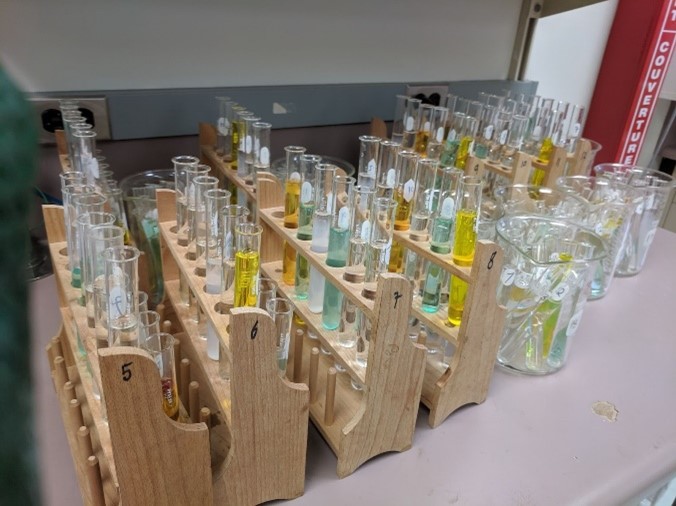
Identify 12 mystery solutions with various chemistry techniques.
In a Grade12 Chemistry classroom, the teacher presented the aqueous unit with a set of 12 test tubes containing 12 different solutions. Every learner received the same 12 solutions but in a different order so that each group of learners needed to conduct their own investigation. The learners were asked, “Can you identify these 12 solutions?”
These three week–long projects required the learners to read, plan, execute, and re-evaluate the identity of the 12 solutions. At the beginning of the unit, the learners were provided with a project booklet that included the necessary notes, sample questions, and mini-labs to aid in their identification of the solutions. They were also provided with the 12 potential solutions that were used in creating the 12 mystery solutions to guide them with their initial research.
To begin, the learners were encouraged to familiarize themselves with the project booklet, and complete preliminary research on the 12 solutions. The research included physical properties such as colour, acidity, and smell, but they could also research the solubility with other solutions. The learners had to find, use, and ask relevant questions to gather the correct information to help them plan out their testing.
The initial task of the project was somewhat daunting as it was very open-ended. Some learners found this process challenging, as they were not instructed where or how to start the process. To support the learners’ perseverance, the teacher acknowledged the challenging nature of the project and encouraged them to work through the murkiness of the learning, ensuring them that the research, the mini-labs, and some teacher-generated practice questions would help them work through their understanding.
Once the learners had completed their initial research, the class developed and planned out how they would start the investigation. Some groups thoroughly read the provided notes, while others jumped right into the identification of the solutions.
The teacher set out mini-labs that mimicked the project at a smaller scale such as having a lab to test the pH of the solutions by using various pH indicators, and a solubility lab to have the learners visually see what a precipitate solution looks like compared to a soluble solution.
Additionally, the teacher ensured the learners had the necessary content understanding, such as the details in writing ionic equations and the formation of precipitate equations, by providing practice questions at the end of each week. These benchmark assessments provided the learners with feedback on their understanding as a form of formative assessment.
As the learners worked through the process of identifying the 12 solutions, they were encouraged to complete detailed notes, take pictures, and complete a solubility table of their solutions. Once they had tentatively identified their 12 solutions, the teacher allowed them three guesses to see if they had correctly identified them. To push them further in their investigation, the teacher only indicated whether they had all the solutions correctly identified. By informing the learners that their first attempt at answers might not be correct, the teacher set the learners up with the mindset that they might need to reconsider their thinking by looking at the evidence anew.
This process was sometimes frustrating and challenging for some as they had to re-evaluate their process and reconsider their thinking. The teacher reinforced their perseverance through the course of the investigation by providing support and guidance in their techniques, and asking guiding questions so they could reflect on their thought processes and determine if their results were consistent with their solutions. The learners persevered through the obstacles and challenges with this guidance and, while not everyone identified every solution correctly, they all learned why or why not as part of the process.
As a final product, the learners were assigned a formal lab report to explain how they identified the 12 solutions. They were provided with a lesson on writing a scientific lab report using past examples and notes. As they were asked to keep a lab journal where they took pictures, created tables for their data, and recorded any observations that they had made on the solutions during the entirety of their investigation, they had a wealth of information to draw upon to describe their process. This report helped the learners to reflect on their learning, consolidate their thinking, and communicate their understanding.
*These descriptors represent the dimensions of global competencies in science.